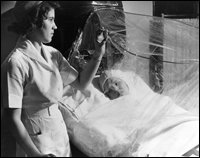World War II Years

In December 1941, after the Japanese attack on Pearl Harbor and the nation declared war against Japan and Germany, men and women throughout the country began to take an active part in the war effort. The staff and employees of Henry Ford Hospital were no exception. By 1945, 350 people had left the Hospital to serve in various branches of military service. The sons of Edsel Ford, Henry II and Benson, were also in the service.
An elaborate plan for civil defense was devised for the hospital in December 1941, and remained in effect until October 1, 1944. By March 1942, the Hospital's 1,000 employees had been trained and assigned emergency responsibilities.

The spring of 1943 brought the somber news of the death Henry Ford's son Edsel, who was only 49 years old. Edsel had served as a member of the hospital's Board since its establishment in 1915, and had been helpful in all areas of the hospital's operations. Following his father's death, Henry Ford II was released from service by the order of Defense Secretary Knox because it was as important to the government as it was to the Ford family that the Ford Motor Company remain capable of war production and avoid chaos in its management.
Nevertheless, Henry Ford Hospital continued to push the envelope of medicine. Dr. Robert Ziegler, who had been chief resident in cardiology, introduced his clinical application of an electrocardiogram with 12 leads instead of the usual four in about 1944 -- five to ten years ahead of many other institutions.
In 1945 the war came to an end and the staff members returned from military service. Henry Ford Hospital observed its 30th anniversary. The combination of increased experience of existing staff, additions of new staff, and advances in medicine resulting from wartime research led to significant changes and improvements in the practice of medicine at the hospital.
Photos: © Property of Henry Ford Health Conrad R. Lam Archives, All Rights Reserved
.svg?iar=0&hash=F6049510E33E4E6D8196C26CCC0A64A4)

/hfh-logo-main--white.svg?iar=0&hash=ED491CBFADFB7670FAE94559C98D7798)